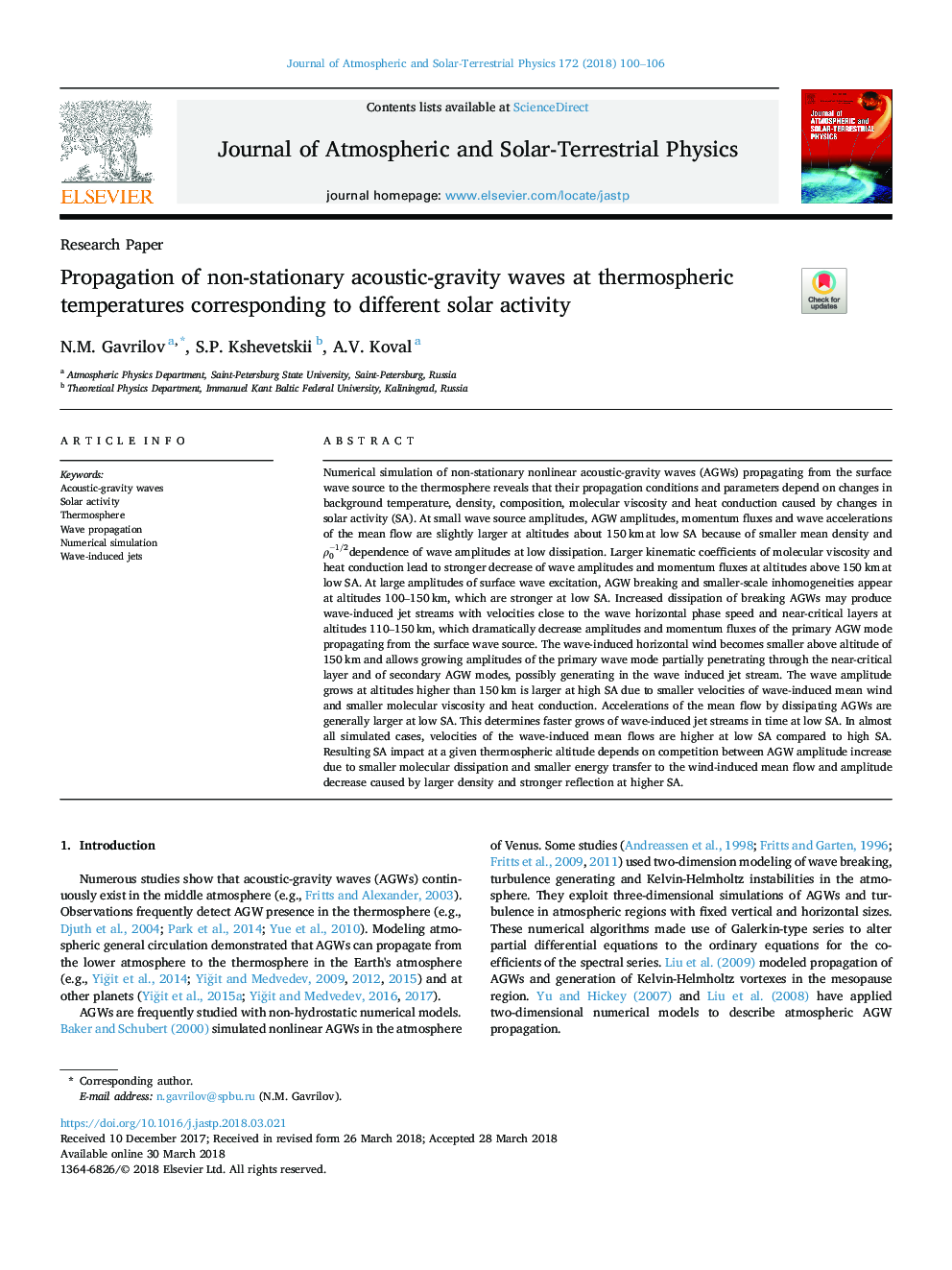| کد مقاله | کد نشریه | سال انتشار | مقاله انگلیسی | نسخه تمام متن |
|---|---|---|---|---|
| 8139453 | 1523579 | 2018 | 7 صفحه PDF | دانلود رایگان |
عنوان انگلیسی مقاله ISI
Propagation of non-stationary acoustic-gravity waves at thermospheric temperatures corresponding to different solar activity
ترجمه فارسی عنوان
انتشار امواج غیر جاذبه ای-گرانشی در دماهای ترموسفریک مربوط به فعالیت های مختلف خورشیدی
دانلود مقاله + سفارش ترجمه
دانلود مقاله ISI انگلیسی
رایگان برای ایرانیان
کلمات کلیدی
موج گرانش آکوستیک، فعالیت خورشیدی، ترموسفر، پخش امواج، شبیه سازی عددی، جت های ناشی از موج،
موضوعات مرتبط
مهندسی و علوم پایه
علوم زمین و سیارات
فیزیک زمین (ژئو فیزیک)
چکیده انگلیسی
Numerical simulation of non-stationary nonlinear acoustic-gravity waves (AGWs) propagating from the surface wave source to the thermosphere reveals that their propagation conditions and parameters depend on changes in background temperature, density, composition, molecular viscosity and heat conduction caused by changes in solar activity (SA). At small wave source amplitudes, AGW amplitudes, momentum fluxes and wave accelerations of the mean flow are slightly larger at altitudes about 150â¯kmâ¯at low SA because of smaller mean density and Ï0â1/2dependence of wave amplitudes at low dissipation. Larger kinematic coefficients of molecular viscosity and heat conduction lead to stronger decrease of wave amplitudes and momentum fluxes at altitudes above 150â¯kmâ¯at low SA. At large amplitudes of surface wave excitation, AGW breaking and smaller-scale inhomogeneities appear at altitudes 100-150â¯km, which are stronger at low SA. Increased dissipation of breaking AGWs may produce wave-induced jet streams with velocities close to the wave horizontal phase speed and near-critical layers at altitudes 110-150â¯km, which dramatically decrease amplitudes and momentum fluxes of the primary AGW mode propagating from the surface wave source. The wave-induced horizontal wind becomes smaller above altitude of 150â¯km and allows growing amplitudes of the primary wave mode partially penetrating through the near-critical layer and of secondary AGW modes, possibly generating in the wave induced jet stream. The wave amplitude grows at altitudes higher than 150â¯km is larger at high SA due to smaller velocities of wave-induced mean wind and smaller molecular viscosity and heat conduction. Accelerations of the mean flow by dissipating AGWs are generally larger at low SA. This determines faster grows of wave-induced jet streams in time at low SA. In almost all simulated cases, velocities of the wave-induced mean flows are higher at low SA compared to high SA. Resulting SA impact at a given thermospheric altitude depends on competition between AGW amplitude increase due to smaller molecular dissipation and smaller energy transfer to the wind-induced mean flow and amplitude decrease caused by larger density and stronger reflection at higher SA.
ناشر
Database: Elsevier - ScienceDirect (ساینس دایرکت)
Journal: Journal of Atmospheric and Solar-Terrestrial Physics - Volume 172, July 2018, Pages 100-106
Journal: Journal of Atmospheric and Solar-Terrestrial Physics - Volume 172, July 2018, Pages 100-106
نویسندگان
N.M. Gavrilov, S.P. Kshevetskii, A.V. Koval,
